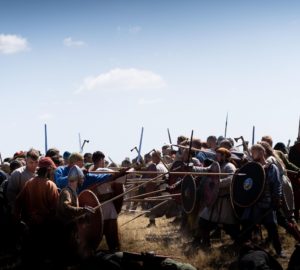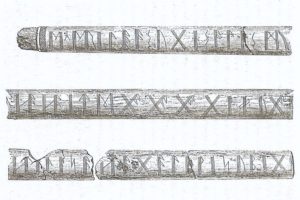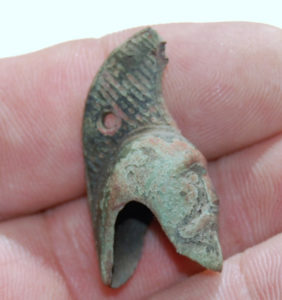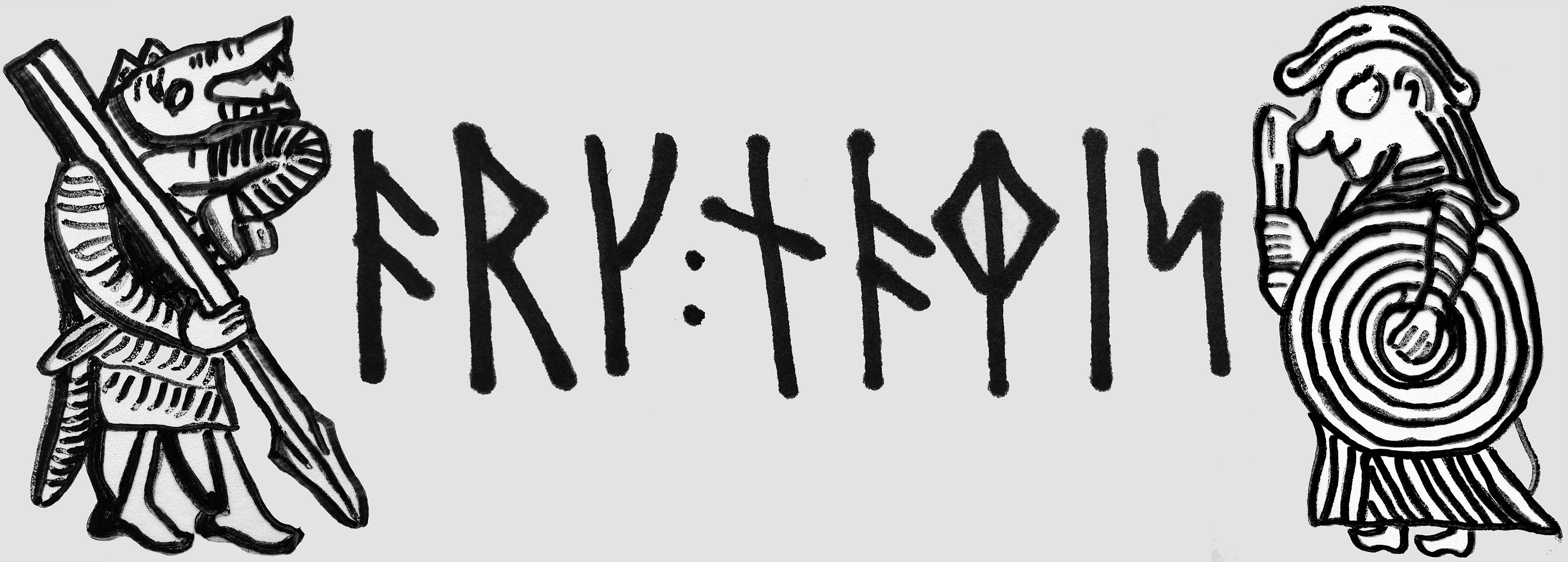
Human-object relations reflected in personal names
Being an archaeologist, a thing that interests me about Scandinavian Iron and Viking Age personal names is the common use of words for objects. A survey through the material has shown that almost all objects represented are weapons or in other ways related to battle. This reflects how the Iron Age society was built around a warrior ideology – especially the social groups who wrote their names in runes on objects and stones.
In later years, archaeologists have been occupied with relationships between objects and humans and the capacity of certain objects to be perceived as charismatic and/or animated – so to say taking on human qualities. Some references are given below. Special pieces of jewellery or weapons would have their own biographies and personhood, and perhaps their own name. Examples from Old Norse literature are the swords Tyrfing, Gram and Skrap and the ring Sveagris. Naming persons with words for objects shows that this was a two-way relationship, where objects could also lend concepts and qualities to the perception of human persons.

One well known example of a name using an object is the modern name Roger, Proto-Scandinavian *Hrōþigaizaz, Old Norse Hróðgeirr. It is comprised of two parts, where the first is Proto-Scandinavian *hrōþi, Old Norse hróð, ‘fame’ and the second Proto-Scandinavian *gaizaz, Old Norse geirr, ‘spear’. This name is perhaps best known from the Old English epic poem Beowulf as the name of king Hrothgar, but the name is also attested in several Viking Age runic inscriptions. It is a classic example of a so-called dithematic personal name – a name that combines two existing words in a composition that has no clear meaning – or at least it is not clear to us. Does this name mean ‘who has a famous spear’ (a possessive compound) or is it rather more poetically meant (a determinative compound) as an analogy or metaphor ‘who is (like) a famous spear’? Some would maybe argue that such a name could have a religious content, referring to the famous spear of the god Odin (which again had it’s own name, Gungnir, ‘the swaying one’).
Weapons used in personal names
The Swedish specialist in personal names, Lena Peterson has created two registries of names in Iron Age and Viking Age runic inscriptions. Here, almost all the words for objects used in naming were related to armour and weaponry with the exception of the Viking Age name/byname m. Hringr, f. Hringia meaning ‘ring, jewellery’ (also suggested to mean ‘man/woman from Ringerike’). I will mention a few examples below.

Spears, shafts and rods
Words for spears, shafts, staffs and rods are perhaps the most common. The above-mentioned name element *gaizaz, Old Norse geirr, ‘spear’ is particularly prominent in Viking Age runic names. It is not attested in earlier runic inscriptions, but is found in early place names with personal name specifics, such as Görslöv and Gärdslöv in Sweden. It can be found in male names as a so-called monothematic name, runic Gæirr (monothematic means a name formed of only one word). It was also used as a second element, runic –gæiRR in numerous combinations such as HialmgæiRR (helmet+spear) and UlfgæiRR (wolf+spear). It is never used as a second element in female names, although found as a first element in names of both women and men. I will however save the theme of female names for a future post.
Another word is represented in the precarious example Ansugīslaz, written on a spear shaft found in Kragehul bog in Denmark. This spear was a part of a large weapon deposit dated to the Late Roman Iron Age. The first element in the name, ansu, means ‘gods/Asir‘. The second element is thought to be a common noun similar to a Longobard word gisil, meaning arrowshaft and an Old Norse geisl m. ‘staff’, geisli m. ‘sunbeam’, meaning ‘beam’ or being a term for a part of a weapon. However, the name has also been seen as a possible byname and related to Old Norse gīsl m. ‘hostage’. This word is not common in the Iron Age runic inscriptions, but is occuring as a monothematic name in quite a few Viking Age inscriptions from Uppland and Västra/Östra Götaland (estimated 19 individuals). This word is found both as a first element Gisl– and a as a second element –gisl.
The combinations of the word for god/gods and spear/shaft/staff has of course again led to speculations about a relation to the god Odin, who had and was associated with a special spear. Bernard Mees for example has written an interesting article about the Kragehul inscription.
Swords and blades
Swords may be the type of object that most often have names in the Old Norse literature. Words for swords or blades also appear in names, though not as common as words for spears, shafts and rods. An early Runic/Proto Nordic word *heruR m. ‘sword’, ON hjórr is found as a first element in a name*Heruwulfaz on the Istaby inscription from Sweden from the 7th or 8th Century AD. It is attested in the form hAeruwulafiz, a probable derivation meaning ‘descendant of Heruwulfaz’. The second element wulfaz means ‘wolf’. Thus, this man was named sword-wolf. This is again a dithematic name where it is unclear whether this combination carried meaning. This name however has a counterpart in the Old English poetic warrior designation, herewulf, revealing how personal names and poetic language could be closely connected. In Beowulf, we also find a name that is a combination of words for sword and spear in Heorogár.
Another Old Norse word brandr m. can both mean ‘stick, post’, ‘fire, burn’ and ‘blade of a sword’, but in personal names it is thought to have been the latter meaning that is most relevant. Brandr is used both as a single element and in names such as Guðbrandr (god + blade). It may have been in use before the Viking Age, as it seems to be the first element in some South Scandinavian place names ending in –lev that we believe were coined between AD 300 and 800.
The male name Saxi is also found on several Viking Age rune stones. This name can be derived from an ethnonym, the name of the Saxons, inhabitants of the former Saxland – but it could also be formed from a word sax meaning ‘short sword’, which was probably the origin of the tribal name.
Here we have an example of a problem often found in personal name studies, discerning between name formations based on tribal names or an original word from which both personal name and tribal name is derived.
Helmets

A very common word (more than 40 attested) used in names attested in Viking Age runic is Kætill or Ketil – also in common use today. This originally stems from a latin loanword, catillus, meaning ‘kettle’ (also the same word). It would probably have taken the alternative meaning ‘kettlehat, helmet’. The name HialmR, ‘helmet’ is also found and today known best as the second element of the name Vilhelm/William etc. HialmR/-hialmR is not attested in any inscriptions of the elder Futhark, but it seems to appear in a couple of the before mentioned lev-names in Denmark.
Charismatic, animated objects with their own personhood
These were only some examples from the extensive runic material. Many more and perhaps other types of objects may be found in the extensive saga literature, where we find vast amounts of names, by-names and nicknames of both historical, fictional and mythological characters. However, I have left out the saga literature from this study, as the name choices can often be literarily motivated or shaped by concerns for stylistic traits such as verse form, rhythm and alliteration. Runic inscriptions and place names I take to represent a better picture of names that were used in real life
The selection of objects related to warfare is first and foremost a testimony to the generally dominating theme of battle and warfare in the personal names. But there may be more to it than that. The correspondence between the objects represented in names with objects that could be perceived as having charisma, personhood, biographies and agency is noteworthy. Interestingly, many of our personal names attested in the elder Futhark were written on the very same types of objects that occur in names and were perceived to have capacities for personhood. In a world with very few inscriptions, these texts lend extra significance to the objects they were inscribed on, and to the names they mention. Here, I may note that there is not a systematic correspondence between name types and their occurrence on object types such as spear-names on spearheads or spear shafts.
In other contexts we often see runes on very elaborate fibulae and in a few cases on neck rings, such as lethro, mentioned in an earlier post. Runes can however also be found on other object types such as whetstones, combs and tools.
The use of objects in personal names adds a perspective to the archaeological debate about human-object relations. The domains of animated, named objects and of personal names using words for objects were somehow entangled. Exactly how this worked is something I am still trying to figure out.
Further reading:
